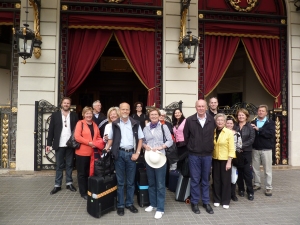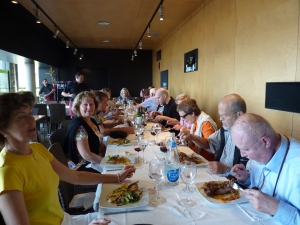
Wine Regions of Spain
All the world’s greatest wine regions share one aspect in common: they are married to a grape or grapes that ripen slowly and exhibit differentiated and sometimes fascinating flavors in differing microclimates within that region.
We’re not sure why slow ripening makes for so many of the world’s great wines, but it does. Hot climates rarely accomplish such slow ripening, so Spain should be incapable of making great wine, right? Well, the popular view of Spain as an arid and hot place is not mistaken, just incomplete. It might be hot in many of Spain’s vineyards, but not for very long. The temperature at night often plummets, and the daylight can be slow to warm the vines.
Elevation is the explanation. Spain is an elevated plateau; little of Spain is at sea level, and while some of the vineyards are as flat as Kansas, many are nearly 3,000 feet above sea level. Many great vineyards are nestled into the creases of mountains. In the Sierra Nevada, along the southern coast, mountains such as Pico Mulhacén jolt up out of the Mediterranean Sea and reach a height of over 10,000 feet less than 30 miles from the shore.
Each of the Spanish wine regions can be defined in its elevation and in its proximity to the ocean or the sea. Some wine authorities prefer to break Spain’s geography into its autonomous regions, but that’s less likely to lead to a more thorough understanding of the places, vineyards, grapes, and styles of the wines of Spain. Rather, the country can be broken into the following climatic categories:
Green Spain
The northern and northwestern portion of Spain, exposed to the northern Atlantic, can be cool to cold, wet, and green—thus its name, España Verde. The sheltering fortification of the Cordillera Cantábrica, looming above Rioja, is unavailable to much of Green Spain as it stretches from Galicia to the Pyrenees. The regions of Ribeiro, Ribera Sacra, Valdeorras, and Bierzo enjoy pockets of protection from the cool, sometimes cold, and often wet coastal influences; Rías Baixas, unfortunately, bears the full force of Atlantic weather. Western Green Spain regions tend to produce high–acid white wines from tart, relatively unripe grapes, while sites in the Pyrenees generate shockingly bracing white wines under the rubric of Txakoli.
North Central Spain
The seat of power for much of Spain’s history, this area hosts extremely elevated but easily workable vineyards along and beyond the banks of the Duero River. Some of the famed wine names in Spain reside in Ribera del Duero, such as Vega Sicilia and Pesquera, and regions such as Toro and Rueda are on the shortlists of anyone pursuing emerging Spanish brands.
Ebro River Valley
The Sierra de Cantábria mountains shelter some of Spain’s most important vineyards, including those in Rioja and Navarra. Farther south, Calatayud, Campo de Borja, and Cariñena offer great value. To the east, vineyards nestled along the base of the foothills of the Pyrenees hold vineyards as well, where tributaries of the River Ebro nurture the vineyards of DO Somontano and the rare Moristel grape that charms many tasters with its tangy fruit and easy ways, along with more muscular Tempranillo, Cabernet Sauvignon, Merlot, and other red varieties.
The Meseta
The “tabletop” that represents the center of the elevated plateau that is Spain is not a uniformly flat, hot, and arid place. Instead, there are significant mountainous spots that offer the possibility of making high–quality wines, based upon strong differences between daytime and n ighttime temperatures (grapes seem to like diurnal temperature swings). The northern piece of the Meseta lies in Castilla y León. The southern portion of the Meseta, Castilla–La Mancha, is producing striking wines based upon dramatic diurnal temperature swings, and even more importantly, remarkably old and healthy vineyards.
ighttime temperatures (grapes seem to like diurnal temperature swings). The northern piece of the Meseta lies in Castilla y León. The southern portion of the Meseta, Castilla–La Mancha, is producing striking wines based upon dramatic diurnal temperature swings, and even more importantly, remarkably old and healthy vineyards.
The Mediterranean Coast
The warmth of the coast from the French border to Almería can be mitigated by high altitudes, whether in Cataluña or in Valencia. Throughout most of this area, world–class wines are appearing in places such as Priorat and Montsant, as well as established areas such as Penedés. Cava, the most famous sparkling wine in the world after Champagne, makes its home near Barcelona.
Andalucía
With temperatures easily surpassing 100°F in the summer, this is an area ideal for fortified and dessert wines. Everything conspires to make a singularly successful fortified wine that comes in a plurality of styles. Although we call all of them Sherry, each of these styles—Manzanilla, Fino, Amontillado, Palo Cortado, Oloroso, and Pedro Ximénez—expresses a unique set of aromas and flavors.
With the Canaries off in the Atlantic and the Balearics lying in the middle of the Mediterranean, both groups of islands enjoy temperatures that are relatively moderate, especially in the sometimes remarkably elevated areas.
Make no mistake, these divisions defined above must make the Spanish crazy: a country barely held together for much of its existence doesn’t take kindly to this American gerrymandering. We hope the producers, growers, vintners, consejos reguladores, and bureaucrats who are responsible for these brilliant wines will forgive our tinkering. We think non–Spanish readers will be able to learn more by viewing Spain’s DOs through the prism of climate, geography, and morphology rather than through political divisions.



